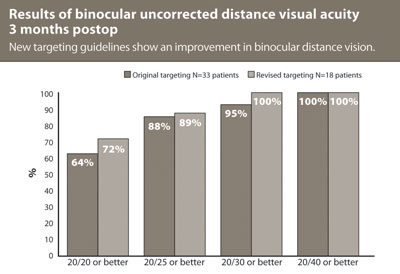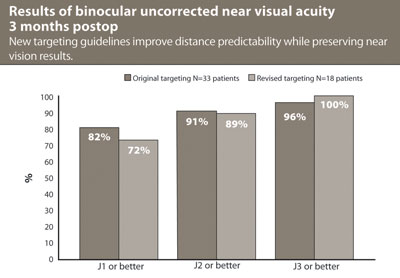Revised accommodating IOL targeting guidelines help improve distance visual acuity
Physicians generally err in favor of myopia when the exact lens power needed to achieve plano is unavailable.
 Jeffrey Whitman |
BOSTON — New lens power targeting guidelines for an accommodating IOL significantly improved distance visual acuity, a surgeon said here.
Jeffrey Whitman, MD, presented results of a study comparing old targeting guidelines to new guidelines for the Crystalens HD single-focus accommodating IOL (Bausch + Lomb) at the American Society of Cataract and Refractive Surgery meeting.
“Distance acuities improved after targeting changes, especially in the 20/20 and 20/25 segments,” Dr. Whitman said. “Little change in intermediate and near vision occurred.”
The new guidelines took effect in April 2009.
When precise IOL calculation targets are unavailable, the generally accepted refractive error is just above plano in the distance eye and just below plano in the near eye, Dr. Whitman and colleagues said in the study abstract.
“When the exact lens power needed to achieve plano is not available, conventional wisdom is to err on the side of myopia,” they said. “Analysis of the first cohort of eyes implanted with the Crystalens HD IOL suggested a different targeting strategy, which is demonstrated in this study.”
Investigators used 3-month outcomes to compare the original guidelines and revised guidelines.
The Crystalens, made of a third-generation silicone material, has a 5-mm optic and a 360° square-edged design. It is available in two lengths corresponding to lens power. The central optic is slightly thicker than in previous models to enhance the axial effect in the center of the lens, Dr. Whitman said.
Gains in uncorrected distance visual acuity
Thirty-three patients in Dr. Whitman’s practice were implanted with lenses under the original targeting guidelines, and 18 patients were implanted under the new guidelines. The global SurgiVision database included 3,000 eyes implanted under the original guidelines and 374 eyes implanted under the new guidelines.
Data on binocular visual outcomes were from Dr. Whitman’s patient subset. Data on monocular outcomes were from the SurgiVision database.
Data showed that 32% of patients implanted under the original guidelines and 42% of patients implanted under the new guidelines had binocular uncorrected distance visual acuity of 20/20 or better.
“We see very good distance visions, but if you compare the two in terms of binocular, 100% are 20/30 or better and almost 90% are 20/25 or better,” he said. “So, it remained even that the percent with 20/20 was slightly better on the new targeting side. New targeting makes a difference there.”
 Source: Whitman J |
 Source: Whitman J |
Data also showed improvement in binocular uncorrected intermediate visual acuity, Dr. Whitman said.
“We know that it’s a very good intermediate lens,” he said. “Even with the targeting, it really doesn’t change results.”
Results for binocular uncorrected near visual acuity were similar in both groups; 60% of patients implanted under the original guidelines and 58% of patients implanted under the new guidelines saw J1 or better.
“There really isn’t much change statistically. That’s a good outcome, because what we see is more predictable distance outcomes without harming near visual acuity,” Dr. Whitman said.
The global database showed improvement in all parameters of monocular uncorrected distance visual acuities, Dr. Whitman said. – by Matt Hasson

- Jeffrey Whitman, MD, can be reached at Key-Whitman Eye Center, 2801 Lemmon Ave., Suite 400, Dallas, TX 75204; 214-754-0000; e-mail: whitman@keywhitman.com.
